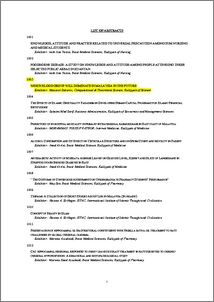Ganikhodjaev, Nasir and Saburov, Mansoor
(2013)
Which blood group will dominate in Malaysia in the future.
In: IIUM Research, Invention and Innovation Exhibition (IRIIE) 2013, 19-20th February 2013, Cultural Activity Centre (CAC) and KAED Gallery, IIUM.
![[img]](http://irep.iium.edu.my/style/images/fileicons/application_pdf.png)  Preview |
|
PDF (Which blood group will dominate in malaysia in the future)
- Published Version
Download (1MB)
| Preview
|
Abstract
A blood group provides an ideal opportunity for the study of human variation without cultural prejudice. It can be easily classified for many different genetically inherited blood typing systems. Also significant is the fact that we rarely take blood types into consideration in selecting mates. A few people know their own type today and no one did prior to 1900. As a result, differences in blood type frequencies around the world are most likely due to other factors than social discrimination. All human populations share the same 29 known blood systems, although they differ in the frequencies of specific types. When we donate blood or have surgery, a small sample is usually taken in advance for at least ABO and Rh systems typing. You inherited your blood types from your parents and the environment in which you live cannot change them. We have learned a good deal about how common each of the ABO blood types is around the world. It is quite clear that the distribution patterns are complex. About 21% of all people in the world share the A allele. The highest frequencies of A are found in small, unrelated populations, especially the Blackfoot Indians of Montana (30-35%), the Australian Aborigines (many groups are 40-53%). Overall in the world, B is the rarest ABO blood allele. Only 16% of humanity have it. Note that it is highest in Central Asia and lowest among the indigenous peoples of the Americas and Australia. The O blood type is very common around the world. About 63% of humans share it. Type O is particularly high in frequency among the indigenous populations of Central and South America, where it approaches 100%. The rest of people in the world are sharing AB blood allele. One of the interesting problems in blood group distributions is that if we know the current blood group distributions of the society then can we predict the blood groups distributions in the future. By concerning this problem, we collected some data from Pahang and Kuala Lumpur states of Malaysia and provided a mathematical model of the human blood group transmission. By means of his model, he tried to predict the future blood group distributions in Malaysia (Pahang and Kuala Lumpur states). In this poster, we are going to present our results.
Actions (login required)
 |
View Item |


 Download Statistics
Download Statistics Download Statistics
Download Statistics